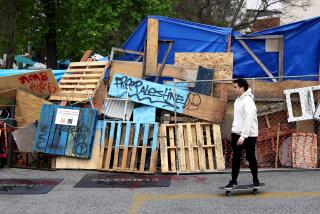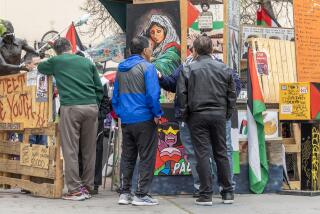Mixed Report Card for University’s First Semester : Education: Faculty, administration and students give fledgling Cal State San Marcos high marks for academic freedom, but some ‘Incompletes’ in other areas.
When last we heard from Janet Powell, she had just given up her sporty Ford Mustang and sprawling Indiana home and was preparing to come teach at Cal State San Marcos.
Now, six months later, she tools around in a used Plymouth van and lives in a three-bedroom Vista condo with a Spanish-tile roof. She’s not looking back.
Powell, like many of the faculty at the fledgling campus, has been both overwhelmed by and enraptured with the challenge of putting together a new university and the opportunity to form curricula.
The promise that was made to Powell and others was that, by coming to a new university, they would be turned loose to design innovative programs befitting a university of the 21st Century.
“There’ve been sacrifices, but the good things really outweigh the negatives,” said Powell, an assistant professor of education. “The opportunity to start a new university is hard to pass up, and it has proven to be everything I thought it would be.”
Biology professor Larry Cohen also likes the chance to create programs from scratch, but in his case, the program depends on lab space he lacks and whose funding is uncertain.
Without that money, “the whole program that I envisioned when I came here is in trouble,” Cohen said.
As the university completed its first semester this month, faculty, administration and students are giving the institution a mixed report card--some A’s, some C’s and more than one Incomplete.
Indeed, the university has faced some tough moments this semester.
* Before school even began, state budget squeezes forced reductions in the number of administrators hired for the campus.
* The university got its first taste of public embarrassment during the first week of school when the university president announced the acceptance of a $250,000 endowment and then hastily reversed himself the next week after the conditions of the endowment were criticized by others in academia.
* University administrators this month finally conceded that it is unlikely that three of the four new campus buildings will be opened on time in August, 1992. Construction has been delayed due to difficulties with a contractor.
* Recent budget cuts and the defeat by state voters last month of Proposition 143, a $450-million higher-education construction bond, has jeopardized $10 million in equipment and furnishings for the campus buildings once they are built.
University President Bill Stacy, while acknowledging the difficulties so far, expressed satisfaction over what he feels has been the most important accomplishment: a favorable relationship between students and faculty.
But Stacy, who a year and a half ago left the friendly trappings of Southeast Missouri State, also reminisced about simpler places and times when his campus could act autonomously.
“When you had an idea for a new policy or program, you worked with it, and when the board adopted the policy, it was done,” Stacy said of the university along the Mississippi River where he had been president for 10 years.
Now Stacy deals with “lots of layers of review” within the California State University bureaucracy.
“It’s almost like driving in California. You have more negotiations, more traffic along the way,” Stacy said. “There are just more hurdles to jump here, more things to do before you get on, and you have to put up with these things.”
Cal State San Marcos’ fund-raising record is unprecedented among small CSU campuses. The university so far has raised more than $1 million in private donations and endowments, including $500,000 over the next 10 years from Itoman & Co., a Japanese trading firm, and a $250,000 endowed chair in communications from Bill Daniels, owner of Daniels Cablevision and Daniels & Associates.
However, a $250,000 endowment offered by Allan O. Kelly, a Carlsbad rancher, was rejected after other academics voiced concern that the gift and the strings attached to it would make the university the laughingstock of the nation’s educational community.
The endowment in geology would have required the endowed professor, whose salary would have been paid with taxpayer money, to study Kelly’s theories of geology, ideas widely regarded as outlandish.
George Boggs, president of neighboring Palomar Community College, said Cal State San Marcos has earned a reputation for being innovative.
“From what I’ve seen, they are very much interested in being creative and developing a university for the new century,” Boggs said.
Some professors, while they knew they faced the task of building a new university, didn’t realize quite what that entailed until they got here.
“Once you get here, then reality shakes you into ‘Oh my God, we’ve got to really build a university,’ ” said Len Jessup, a business faculty member.
Every professor has taken positions on several committees that make decisions on everything from curriculum to campus planning.
Jessup, who received his doctorate from the University of Arizona a year and a half ago, sits on six to nine committees. (“I’m not quite sure, there are so many,” he said.) Last year, as an assistant professor at Cal State Long Beach, he sat on two.
“We’re definitely making real progress,” Jessup said. “However, we also definitely feel like we’re under the gun. It would be nice to be more deliberate about things.
“Between the teaching and meetings, it takes up the time, and for me, a tenure-track professor, you’ve got to find time to research,” he said.
Biology professor Cohen agreed. The university, which sits in temporary quarters in a business park, had planned for laboratories, but they didn’t meet city codes, he said. Lab time is borrowed from Palomar College, and there are plans to develop labs in another San Marcos business park by next semester.
The lack of research space for now “is an annoyance, but with time it ceases to become an annoyance and starts to impact careers,” Cohen said, referring to junior faculty who must conduct research in order to get tenure and receive research grants.
“The longer you wait between productive periods, the more you jeopardize your ability to get funding. There’s a time clock ticking here,” Cohen said.
Plans for the new labs are in their final stages, but there are still questions over where the funding, probably more than $100,000 a year, will come from, he said.
Still, the reason Cohen came to Cal State San Marcos, and the university’s main selling point in attracting faculty, has been the opportunity to forge new paths in education.
Cohen’s vision for his biology curriculum is to emphasize laboratory experience rather than classroom lectures because it is “the excitement of discovery” that attracts and develops science students.
Bernard Hinton, acting dean of the college of business, is also pushing for new trends.
The business program includes working with local businesses that will act as mentors to students, an international focus on curriculum that features a foreign-language requirement and substantial writing in every course, as well as an emphasis on technology with networked computers at every student’s seat.
Some departments have pulled away from traditional academia by putting a non-European focus on their course work.
The only course that Donald Funes, the sole professor of fine arts at the university, taught this past semester was a course in Andean music and culture.
Next semester one of Funes’ classes “explores the music of Native Americans, black music in America, West African Music, European folk music and the music of India,” according to the class schedule.
Funes, a classical flutist, will also continue the Andean Ensemble that was created this semester and which specializes in the music of Bolivia, Peru, Ecuador and Chile.
Some students find the young university, with its small classes and close quarters, a more hospitable environment than other colleges they’ve attended.
“There is a large group of women all raising families, and we all have similar problems struggling with classes and raising kids and balancing our budgets,” said Donna Shaw, an English student and a mother of three who transferred from Palomar College.
At another school, “I would’ve just been one of the few re-entry students and there wouldn’t be a community of us there,” she said of her tightknit group of fellow students at San Marcos.
But the small campus has its drawbacks, such as limited course offerings and even less choice in what professors a student can choose.
“If you have to take three or four classes a semester and you only have five to choose from, there’s not much choice,” said Kathy Sullivan, an English major who finds herself in such a situation.
While professors universally praised their students for being serious about their education, Ramona de Sanchez, a 21-year-old transfer student from Cal State San Bernardino, said courses at her new university are proving easier than she had expected.
“The classes have been interesting and we have excellent professors in general. But at CSU San Bernardino, your upper-division classes were more difficult than here. The expectations were a bit higher there also,” said De Sanchez, a biology major.
Overall, however, most students seem to agree that the university, sometimes chidingly referred to as “Jerome’s West” because of its location next to a furniture store, has surpassed its surroundings.
“Here you have a place that’s locked between warehouses, and I didn’t expect anything but a minimalist education,” said Kathy Sullivan. “But it’s gone beyond that.
“The ambience of the traditional ivy-covered walkways, you don’t have that here, so what you have is made by yourself, and that’s what’s special.”
More to Read
Sign up for Essential California
The most important California stories and recommendations in your inbox every morning.
You may occasionally receive promotional content from the Los Angeles Times.










